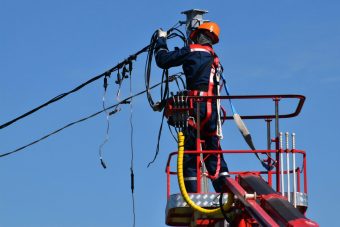Electricity grids are the backbone of energy systems, from which complex and interconnected lines branch out, enabling even the most remote places in the country to access electricity. In the first half of 2025, the world witnessed three major collapses of national electricity systems, leaving millions of people without power, water, communication, and in the dark. Chile, Spain, and Portugal experienced incidents that highlighted the potential and current weaknesses of new energy mixes combined with traditional infrastructure.
Chile – the land of the sun in the darkness
On 25 February 2025, Chile experienced one of the most serious energy incidents in its recent history. In the afternoon hours, a sudden and widespread collapse of the power grid occurred, leaving over 90 percent of the country without electricity within a short time, including the capital city, Santiago.
According to preliminary analyses currently available to the public, an unplanned outage occurred in one region along a high-voltage transmission line connecting the north to the central system. Unexpected activation of protective systems, still under investigation, due to certain circumstances, led to their shutdown, which then triggered a cascading effect of destabilization.
At the time of the blackout, most of the country’s electricity was coming from renewable sources – not an uncommon situation in Chile. Among other sources, Chile has a large number of solar power plants that produce and supply significant amounts of electricity on a daily basis. Moreover, the northern part of the country, including the Atacama Desert – the world’s driest desert – is particularly abundant in solar capacity, which is enhanced by the number of sunny days, geography, and open space.

Renewable energy sources – such as solar power plants and wind farms that depend on weather conditions – are often located in regions with favorable conditions for production, generating large amounts of energy even at considerable distances from main consumption centers. The transmission grid has limited capacity, so if a fault or imbalance occurs on a key line, the surplus electricity cannot be easily rerouted. There are insufficient alternative routes or energy storage systems, so the surplus is discarded, and the grid becomes unstable.
Due to the heavy reliance on decentralized production from renewables, without adequate stabilization infrastructure, systems are often unable to overcome immediate issues. When the north and south were left without their main connection, an imbalance arose between the electricity surplus in the north and the deficit in the center, where consumption is higher due to the population size.
During the hours-long power outage, life in the country was seriously disrupted. In the capital, Santiago, which was particularly affected, traffic collapsed as traffic lights stopped working, and the metro system, which transports over two million people daily, was forced to carry out an emergency evacuation of passengers. People were trapped in lifts, while hospitals continued to operate under challenging conditions thanks to backup generators.
The government soon declared a state of emergency and imposed a curfew to prevent potential unrest and ensure emergency services could function. At the same time, the banking sector came to a halt as electronic transaction systems went down.
By the morning of the following day, 26 February, electricity had been gradually restored to around 90 percent of households, according to reports from the National Electric System Coordinator (Coordinador Eléctrico Nacional).
For many years, Chile has operated under a liberalized and privatized energy model, where various companies manage electricity production, transmission, and distribution, while the main public institution plays a role of oversight and technical coordination but does not have operational control over the infrastructure. Critics argue that this model has led to the lack of a unified crisis centre and proper coordination, highlighting the need for a stronger state role in network oversight and greater investment in infrastructure to balance and protect the system from cascading failures.
IN FOCUS:
- A School Project That Turns Waste PET Packaging into 3D Printing Filament
- The Household of the Future – A Farm as an Energy Producer
- GreenCleanS as a Response to the Environmental Challenges of Oil Regeneration
Energy collapse of the Iberian Peninsula
The next major energy collapse occurred roughly two months later, on the European continent, on 28 April this year, around 12:30 local time, when the electricity systems of Spain and Portugal suffered a total shutdown.
It all began with a series of frequency fluctuations in southwestern Spain. The most critical fluctuation triggered protective mechanisms in France, which cut the interconnection with the Spanish system. This severed a key flow of electricity between the peninsula and the rest of Europe, leaving the region energy-isolated. Although preliminary findings have identified several events that led to the blackout, including frequency and voltage fluctuations and a sharp drop in production, the exact cause of all changes and components awaits official clarification.
Without support from the continental grid, the Spanish and Portuguese systems had to rely solely on their own resources. As the grid began to lose balance, power plants were automatically shut down, and the grid soon collapsed entirely.
Initial data from the Spanish grid operator pointed to unusually low-frequency oscillations between the Iberian Peninsula and the main European network just before the blackout, according to the WindEurope association.
At the time of the incident, renewable sources accounted for a significant share of electricity production in Spain, also a typical scenario for this region, prompting public discourse around the challenges renewables may pose during moments of technical instability.
Solar power plants are connected to the grid via inverters, which are designed to automatically shut down the plant if they detect unstable grid conditions, such as a frequency falling below a permitted threshold or excessively high voltage. In this case, the inverters may have detected certain instabilities and immediately shut down the solar systems—a standard safety mechanism designed to protect both the grid and the equipment. This resulted in the loss of a significant portion of the electricity being produced at the time.
Under ideal conditions, the loss of solar energy is compensated by battery storage systems or flexible power plants such as gas or hydroelectric stations. However, Spain did not have sufficient capacity to make up for the drop in real time.
Once the solar power plants shut down, the load was automatically transferred to other sources. Nuclear reactors have strict safety protocols, which means that when they detect such deviations in grid parameters, they shut down to prevent risk. The grid continued to lose balance, and eventually, the entire system collapsed.

Some expert circles believe that in situations where there are frequency deviations, a generation mix with a large share of renewables can accelerate system destabilization, as these sources do not provide inertia—the ability of the grid to naturally resist rapid changes in frequency—as conventional power plants with rotating generators do. Nevertheless, this only highlights the need to adapt the grid to the new technological demands of the modern energy transition.
As in the previous case, metro systems in Madrid, Barcelona, Lisbon, and Porto came to a halt, leaving passengers stranded. Hundreds of trains, including high-speed lines between major cities, had to be stopped. Traffic was in chaos due to inactive traffic lights, and operations at the main airports were suspended. Hospitals switched to generators, while water, internet, and digital services were unavailable across the country. The police were mobilized to maintain order and ensure emergency assistance.
Still, by the next morning, more than 99 percent of the system had been stabilized. However, the damage—economic, social, and infrastructural—had already been done.
Conclusion
Although providing an official and comprehensive explanation will take time, it is clear that stability in the 21st century must be built in parallel with capacity, through the use of battery storage, flexible sources, and regional coordination. The energy transition must be accompanied by the development of stable and resilient domestic infrastructure to avoid falling behind the expansion of renewable energy sources.
Prepared by Milica Vučković
The story was published in Energy portal Magazine PURE ENERGY

